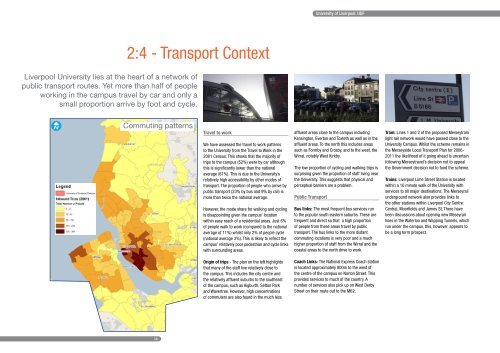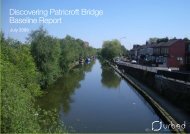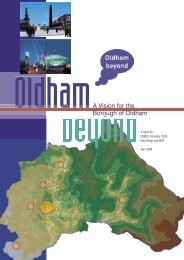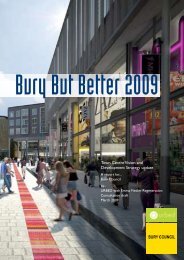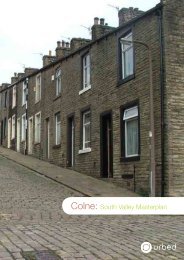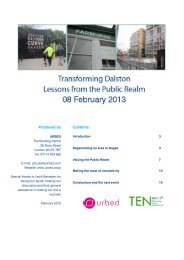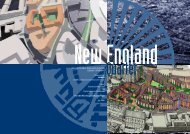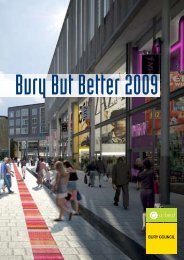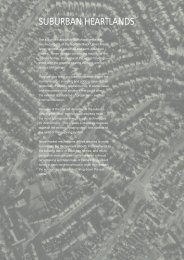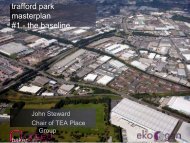URBAN DESIGN FRAMEWORK The University of Liverpool - Urbed
URBAN DESIGN FRAMEWORK The University of Liverpool - Urbed
URBAN DESIGN FRAMEWORK The University of Liverpool - Urbed
You also want an ePaper? Increase the reach of your titles
YUMPU automatically turns print PDFs into web optimized ePapers that Google loves.
<strong>University</strong> <strong>of</strong> <strong>Liverpool</strong>: UDF1.2.52:4 - Transport Context<strong>Liverpool</strong> <strong>University</strong> lies at the heart <strong>of</strong> a network <strong>of</strong>public transport routes. Yet more than half <strong>of</strong> peopleworking in the campus travel by car and only asmall proportion arrive by foot and cycle.Figure 2: Trip origins <strong>of</strong> work related trips to the <strong>University</strong>1.2.5Commuting patternsTravel to workWe have assessed the travel to work patternsto the <strong>University</strong> from the Travel to Work in the2001 Census. This shows that the majority <strong>of</strong>trips to the campus (52%) were by car althoughthis is significantly lower than the nationalaverage (61%). This is due to the <strong>University</strong>’srelatively high accessibility by other modes <strong>of</strong>transport. <strong>The</strong> proportion <strong>of</strong> people who arrive bypublic transport (23% by bus and 9% by rail) ismore than twice the national average.However, the mode share for walking and cyclingis disappointing given the campus’ locationwithin easy reach <strong>of</strong> a residential areas. Just 6%<strong>of</strong> people walk to work (compared to the nationalaverage <strong>of</strong> 11%) whilst only 2% <strong>of</strong> people cycle(national average 3%). This is likely to reflect thecampus’ relatively poor pedestrian and cycle linkswith surrounding areas.affluent areas close to the campus includingKensington, Everton and Toxteth as well as in theaffluent areas. To the north this includes areassuch as Formby and Crosby, and to the west, theWirral, notably West Kirkby.<strong>The</strong> low proportion <strong>of</strong> cycling and walking trips issurprising given the proportion <strong>of</strong> staff living nearthe <strong>University</strong>. This suggests that physical andperceptual barriers are a problem.Public TransportBus links: <strong>The</strong> most frequent bus services runto the popular south-eastern suburbs. <strong>The</strong>se arefrequent and direct so that a high proportion<strong>of</strong> people from these areas travel by publictransport. <strong>The</strong> bus links to the more distantcommuting locations is very poor and a muchhigher proportion <strong>of</strong> staff from the Wirral and thecoastal areas to the north drive to work.Tram: Lines 1 and 2 <strong>of</strong> the proposed Merseytramlight rail network would have passed close to the<strong>University</strong> Campus. Whilst the scheme remains inthe Merseyside Local Transport Plan for 2006-2011 the likelihood <strong>of</strong> it going ahead is uncertainfollowing Merseytravel’s decision not to appealthe Government decision not to fund the scheme.Trains: <strong>Liverpool</strong> Lime Street Station is locatedwithin a 10 minute walk <strong>of</strong> the <strong>University</strong> withservices to all major destinations. <strong>The</strong> Merseyrailunderground network also provides links tothe other stations within <strong>Liverpool</strong> City Centre:Central, Moorfields and James St. <strong>The</strong>re havebeen discussions about opening new Meseyraillines in the Waterloo and Wapping Tunnels, whichrun under the campus, this, however, appears tobe a long term prospect.Origin <strong>of</strong> trips - <strong>The</strong> plan on the left highlightsthat many <strong>of</strong> the staff live relatively close tothe campus. This includes the city centre andthe relatively affluent suburbs to the southeast<strong>of</strong> the campus, such as Aigburth, Sefton Parkand Wavertree. However, high concentrations<strong>of</strong> commuters are also found in the much lessCoach Links: <strong>The</strong> National Express Coach stationis located approximately 800m to the west <strong>of</strong>the centre <strong>of</strong> the campus on Norton Street. Thisprovides services to much <strong>of</strong> the country. Anumber <strong>of</strong> services also pick up on West DerbyStreet on their route out to the M62.14


